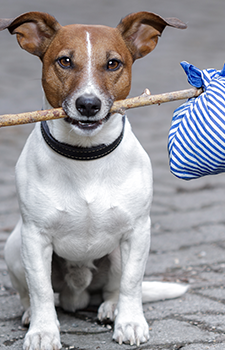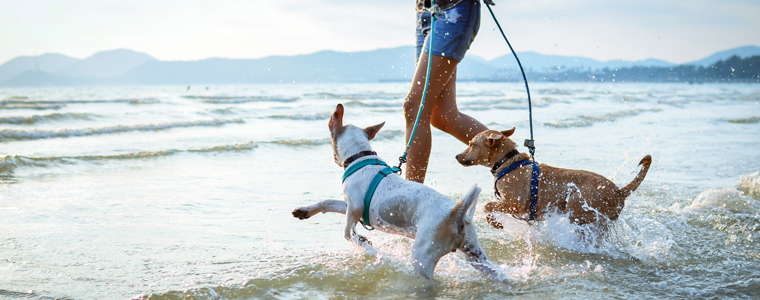Updated May 25, 2023
To many people, pets are family. That’s why, when you’re moving to Hawaiʻi, it’s important to be able to take your dogs, cats, and other pets to your new home.
Moving pets to Hawaiʻi can be a little tricky. Because it’s the only state in the U.S. that’s rabies free, the Hawaiian Islands have very strict protocols for bringing in cats, dogs, and other domesticated animals. Additionally, because of the islands’ unique and delicate ecosystem, some animals are entirely restricted.
To help you understand the process for moving your pets to Hawaiʻi, we put together this guide. We’ll connect you with the forms, checklists, information, and resources you need to get your whole family to Hawaiʻi, quickly, safely, and easily.
In This Article:
Step 2: Preparing for the Right Quarantine Program
Step 3: Prepare Your Pet for the Trip
- Can I Bring My Dog If I Move to Hawaiʻi?
- Can I Move My Cats to Hawai’i?
- How Many Cats Can You Own in Hawaiʻi?
- Is There a Limit to How Many Dogs You Can Have in Hawaiʻi?
- Do Cats Have to Quarantine When Moving to Hawaiʻi?
- How Hard Is It to Bring a Dog to Hawaiʻi?
- Which Airlines Allow Cats in the Cabin to Hawaiʻi?
- How Can I Avoid Pet Quarantine in Hawaiʻi?
- How Much Does It Cost to Fly a Dog to Hawaiʻi?
- Why Are Hawaiʻi’s Rules for Pets So Different?

STEP 1: Verify That Your Pet Is a “Go” for Hawaiʻi
You might be surprised to know that some common pets in the United States are not allowed in Hawaiʻi. For example, several types of birds, snakes, and hamsters are on the no-go list. Guinea pigs, however, are welcome in Hawaiʻi.
Before you go through the importation process, you’ll want to verify that your pet will be allowed in the state. Importing an illegal animal carries a penalty of up to three years in prison and fines up to $500,000, so you’ll want to be 100% certain before bringing your pet with you.

Pets Who Get the Green Light: In general, you’re allowed to bring domesticated dogs and cats to Hawaiʻi, as long as they are not cross-bred with a wild animal, such as a cat cross-bred with a lynx or wolf-dog crossbreeds.
In addition to dogs and cats, you’re also allowed to bring pets like guinea pigs, chinchillas, and several varieties of parrots. If you have any questions, check the official list of conditionally-approved animals from the Hawaiʻi Department of Agriculture.

Pets Who Get the Red Light: If you’re bringing something more exotic than a Fluffy or a Fido into Hawaiʻi, make sure to review the list of prohibited pet imports, which forbids:
- Caribbean hermit crabs (Coenobita clypeatus)
- All types of snakes
- Porcupines
- Hamsters (or any members of the family Cricetidae)
- Geckos
- Snapping turtles
- Toucans
- Pregnant animals

Pets Who Get the Yellow Light: Although not restricted from entry, some types of pets may require some extra consideration on your part.
- Puppies and kittens: Due to the minimum amount of time needed to prepare a puppy or kitten to meet the requirements of the 5 Day or Less quarantine program, a puppy or kitten will be about six months of age by the time preparations are completed. Puppies and kittens not able to meet all of the requirements for the 5 Day or Less program will be quarantined for 120 days. (More on the different types of quarantine programs in the next section!)
- Older animals may not respond well to the stress of traveling. Additionally, pets who do not handle a tropical climate well may not be good candidates for Hawaiʻi.
Once you’re sure your pet is cleared for conditional import to Hawaiʻi, you’ll want to check the requirements for importing your pet:
Domesticated Animals | Non-Domestic/Uncommon Animals
Dogs and cats are the most common pets our customers inquire about. We’ll walk you through their Hawaiʻi import requirements next.

STEP 2:
Prepare for the Right Quarantine Program for Your Dog or Cat
If you’re moving your dog or cat to Hawaiʻi, there are two main programs – 120 Day Quarantine or Direct Release.

Full 120-Day Quarantine
If your pet falls under this program, you’ll likely have many questions, including: How should I prepare my pet? What will quarantine be like? Where will my pet be kept? The Hawaiʻi Rabies Quarantine Information Brochure offers answers to these common questions—and more. Start on page 31 for information specific to this program.
One of the biggest questions many pet owners have is: Can I visit my pet during quarantine on Oahu? Absolutely! During the quarantine period, you can visit your pet on:
- Tuesdays and Thursdays: 1:00 p.m. to 4:30 p.m.
- Wednesdays: 1:00 p.m. to 5:30 p.m.
- Saturdays and Sundays: 12:00 p.m. to 3:30 p.m.
No visits are allowed on Mondays, Fridays, or state holidays.

Direct Airport Release and 5-Day or Less Quarantine
Pets who qualify for Direct Airport Release can leave the airport with their owners once they pass an entry inspection.
If for some reason, owners can’t pick up their pets immediately after the inspection—or if there’s a glitch in the paperwork that can be resolved quickly—the pets may go into the 5-Day or Less quarantine program. Once the owners can pick up their pets, or resolve the issues, the pets will be released.
You’ll find all the checklists to qualify for this program below, based on your origin and destination points.
If your pet is NOT located in Hawaiʻi:
- Flying into Honolulu – use Checklist 1
- Flying into Kona, Kahului or Līhuʻe – use Checklist 2
If you live in Hawaiʻi and you want to take your pet to the mainland and then return, there’s a different set of requirements for you to follow:
- If you’re flying into Honolulu – use Checklist 3
- If you’re flying into Kona, Kahului, or Līhuʻe – use Checklist 4
To spec out the cost for each program, check the official Animal Quarantine Information page. (And don’t forget to factor in the airline’s fees when putting your budget together!) To give you an overall sense of what’s required, we’ve included an overview of the process if you’re headed from a mainland destination to Oʻahu:

STEP 3:
Prepare Your Pet for the Trip to Hawaiʻi
The flight to Hawaiʻi has been known to test even the hardiest of road warriors. Considering you’re looking at a minimum flight time of five hours—and that’s just the time in the air—you’ll need to do some preparation to make sure your cat or dog is ready for the trip.
Below, you’ll find six tips to help you and your pet travel to Hawaiʻi with maximum ease.
Are There Any Exceptions to These Quarantine Rules?
Yes—in two cases:
#1: Dogs and cats from specific rabies-free countries— including Australia, New Zealand, the British Isles, and Guam—on a direct flight to Hawaiʻi do not require an import permit number, which means they do not need to complete the standard requirements. However, they do need to complete this checklist.
#2: Service and guide dogs have modified quarantine requirements for entering the State of Hawaiʻi. You can find more information about service and guide dogs entering Hawaiʻi on the Animal Industry Division website.
Note: On January 1, 2019, a Hawaiʻi law went into effect that makes it illegal to knowingly misrepresent an animal as a service animal. Violators may be subject to civil penalties.
What Do I Do If I Have More Questions?
A moving company is likely to have some expertise in this arena. However, when it comes to something as important as a member of your family, we recommend going straight to the source.
To contact the Hawaiʻi Department of Agriculture on matters related to quarantine/import of cats and dogs:
- Email: rabiesfree@hawaii.gov
- Call: 808-483-7151
Due to the volume of calls and the time zone difference, the department recommends using their email address to reach out. Additionally, email will offer you a paper trail in case there are any disputes over who said what during your conversations.
Frequently Asked Questions
Moving Your Whole Family with Ease
Once you understand the procedures for clearing your pets into Hawaiʻi—and you have all the checklists you’ll need to complete the right paperwork—your task gets easier. Now, it’s just a matter of working with your vet to gather what you need so every member of your family (even the four-legged ones!) can join you on your Hawaiʻi adventure.
Have other questions about moving to Hawaiʻi? We’d be happy to help! While we don’t move pets, after 35+ years of moving families in, around, and to the Hawaiian Islands, it’s safe to see we’ve seen it all and moved it all. Just reach out to us and let us know how we can help!
Tell us about your move!



